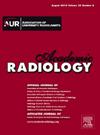基于深度学习算法的核磁共振成像放射组学和病理组学预测直肠癌微卫星不稳定性状态:一项多中心研究。
IF 3.8
2区 医学
Q1 RADIOLOGY, NUCLEAR MEDICINE & MEDICAL IMAGING
引用次数: 0
摘要
原理与目的开发并验证基于临床变量、多参数磁共振成像(mp-MRI)和苏木精及伊红(HE)染色病理切片的多模态深度学习模型,用于预测直肠癌患者的微卫星不稳定性(MSI)状态。第一中心的患者按 7:3 的比例随机分为训练集(242 例)和内部验证集(105 例)。来自中心 2 和中心 3 的患者(120 名)被纳入外部验证(exvad)组。对 HE 和免疫组化(IHC)染色进行分析,并通过 IHC 染色确认 MSI 状态。根据临床评估结果,通过单变量和多变量分析确定了独立的预测因素,并将其用于构建临床模型。利用 ResNet-101 对术前 MRI(T2WI、DWI 和对比增强 T1WI 序列)和术后 HE 染色图像进行深度学习,分别计算出深度学习放射组学评分(DLRS)和深度学习病理组学评分(DLPS),并建立了 DLRS 和 DLPS 模型。结果在所有直肠癌患者中,82人(17.6%)患有MSI。长径(LD)和病理 T 分期(pT)被确定为独立预测因子,并被用于构建临床模型。经过深度学习和特征选择后,最终选择了一组 30 个放射组学特征和 30 个病理组学特征来构建 DLRS 和 DLPS 模型。通过加权线性组合,创建了一个结合临床模型、DLRS 和 DLPS 的提名图。临床模型预测 MSI 的 AUC 值在训练集、入侵集和 exvad 集分别为 0.714、0.639 和 0.697。DLPS 和 DLRS 的 AUC 值在训练集、入侵集和 exvad 集上介于 0.896 到 0.961 之间。提名图的 AUC 值分别为 0.987、0.987 和 0.974,灵敏度分别为 1.0、0.963 和 1.0,特异性分别为 0.919、0.949 和 0.867。在所有集合中,提名图的表现均优于其他三个模型,DeLong 测试结果表明,在训练集合中,提名图的预测性能更优。该模型在预测直肠癌患者的 MSI 状态方面具有很高的预测准确性和通用性。本文章由计算机程序翻译,如有差异,请以英文原文为准。
Deep Learning Algorithm‑Based MRI Radiomics and Pathomics for Predicting Microsatellite Instability Status in Rectal Cancer: A Multicenter Study
Rationale and Objectives
To develop and validate multimodal deep-learning models based on clinical variables, multiparametric MRI (mp-MRI) and hematoxylin and eosin (HE) stained pathology slides for predicting microsatellite instability (MSI) status in rectal cancer patients.
Materials and Methods
A total of 467 surgically confirmed rectal cancer patients from three centers were included in this study. Patients from center 1 were randomly divided into a training set (242 patients) and an internal validation (invad) set (105 patients) in a 7:3 ratio. Patients from centers 2 and 3 (120 patients) were included in an external validation (exvad) set. HE and immunohistochemistry (IHC) staining were analyzed, and MSI status was confirmed by IHC staining. Independent predictive factors were identified through univariate and multivariate analyses based on clinical evaluations and were used to construct a clinical model. Deep learning with ResNet-101 was applied to preoperative MRI (T2WI, DWI, and contrast-enhanced T1WI sequences) and postoperative HE-stained images to calculate deep-learning radiomics score (DLRS) and deep-learning pathomics score (DLPS), respectively, and to DLRS and DLPS models. Receiver operating characteristic (ROC) curves were plotted, and the area under the curve (AUC) was used to evaluate and compare the predictive performance of each model.
Results
Among all rectal cancer patients, 82 (17.6%) had MSI. Long diameter (LD) and pathological T stage (pT) were identified as independent predictors and were used to construct the clinical model. After undergoing deep learning and feature selection, a final set of 30 radiomics features and 30 pathomics features were selected to construct the DLRS and DLPS models. A nomogram combining the clinical model, DLRS, and DLPS was created through weighted linear combination. The AUC values of the clinical model for predicting MSI were 0.714, 0.639, and 0.697 in the training, invad, and exvad sets, respectively. The AUCs of DLPS and DLRS ranged from 0.896 to 0.961 across the training, invad, and exvad sets. The nomogram achieved AUC values of 0.987, 0.987, and 0.974, with sensitivities of 1.0, 0.963, and 1.0 and specificities of 0.919, 0.949, and 0.867 in the training, invad, and exvad sets, respectively. The nomogram outperformed the other three models in all sets, with DeLong test results indicating superior predictive performance in the training set.
Conclusion
The nomogram, incorporating clinical data, mp-MRI, and HE staining, effectively reflects tumor heterogeneity by integrating multimodal data. This model demonstrates high predictive accuracy and generalizability in predicting MSI status in rectal cancer patients.
求助全文
通过发布文献求助,成功后即可免费获取论文全文。
去求助
来源期刊

Academic Radiology
医学-核医学
CiteScore
7.60
自引率
10.40%
发文量
432
审稿时长
18 days
期刊介绍:
Academic Radiology publishes original reports of clinical and laboratory investigations in diagnostic imaging, the diagnostic use of radioactive isotopes, computed tomography, positron emission tomography, magnetic resonance imaging, ultrasound, digital subtraction angiography, image-guided interventions and related techniques. It also includes brief technical reports describing original observations, techniques, and instrumental developments; state-of-the-art reports on clinical issues, new technology and other topics of current medical importance; meta-analyses; scientific studies and opinions on radiologic education; and letters to the Editor.
 求助内容:
求助内容: 应助结果提醒方式:
应助结果提醒方式:


